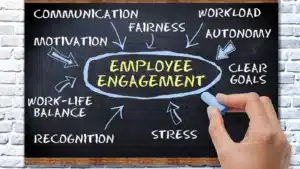
Break the Ice: Best Employee Engagement Survey Questions for Teams
Engaging employees is crucial for fostering a positive workplace culture and enhancing productivity. One effective way to gauge employee sentiment and gather valuable feedback is through employee engagement surveys. These surveys not only help identify areas for improvement but also promote open communication within teams. In this article, we will explore some of the best employee engagement survey questions that can help break the ice and encourage meaningful responses from team members.
Understanding Employee Engagement Surveys
Employee engagement surveys are tools designed to measure the level of commitment, motivation, and satisfaction employees feel towards their work and the organization. These surveys can provide insights into employee morale, identify potential issues, and highlight areas where the organization excels. By systematically gathering this information, organizations can create a more engaged workforce that is aligned with their goals and values.
By using well-crafted questions, organizations can gain a deeper understanding of their employees’ experiences and perceptions. This understanding can lead to actionable insights that drive positive change within the workplace. For instance, if a survey reveals that employees feel overwhelmed by their workloads, management can explore ways to redistribute tasks or provide additional resources to alleviate stress. Such proactive measures not only improve employee satisfaction but also enhance overall productivity.
Why Use Employee Engagement Surveys?
Implementing employee engagement surveys can yield numerous benefits. Firstly, they create a platform for employees to voice their opinions, ensuring that everyone feels heard and valued. Secondly, the feedback collected can help management make informed decisions that enhance workplace culture. Lastly, when employees see that their feedback leads to tangible changes, it boosts their morale and fosters a sense of belonging. This sense of belonging is crucial, as it can lead to increased loyalty and reduced turnover rates, ultimately benefiting the organization’s bottom line.
Moreover, regular engagement surveys can help organizations track changes over time, allowing them to measure the effectiveness of initiatives aimed at improving employee satisfaction. By establishing a baseline and monitoring progress, companies can adapt their strategies to better meet the evolving needs of their workforce. This continuous feedback loop not only strengthens the employer-employee relationship but also cultivates a culture of transparency and trust.
Key Elements of Effective Survey Questions
To ensure that employee engagement surveys are effective, it’s essential to focus on clarity, relevance, and openness. Questions should be straightforward and easy to understand, allowing employees to respond honestly without ambiguity. Additionally, including a mix of quantitative and qualitative questions can provide a well-rounded view of employee sentiments. For example, while numerical ratings can quantify satisfaction levels, open-ended questions allow employees to elaborate on their feelings and provide specific suggestions for improvement.
Furthermore, it’s important to consider the timing and frequency of these surveys. Conducting them at regular intervals, such as annually or biannually, can help capture changes in employee sentiment over time. Additionally, ensuring that surveys are distributed during periods of relative stability, rather than during times of significant organizational change, can yield more accurate and actionable insights. By thoughtfully designing the survey process, organizations can maximize participation and foster a culture of continuous improvement that resonates with their employees.
Icebreaker Questions to Start the Conversation
Starting with icebreaker questions can help ease employees into the survey process. These questions should be light-hearted and encourage employees to share their thoughts freely. Here are some examples:
1. What motivates you to come to work every day?
This question allows employees to reflect on their personal motivations and can provide insights into what drives engagement within the organization. Understanding these motivators can help management create an environment that nurtures these factors. Whether it’s the thrill of tackling new challenges, the joy of collaborating with colleagues, or the satisfaction of achieving personal goals, recognizing these elements can significantly enhance workplace culture and productivity. Additionally, sharing these motivations can inspire others and foster a more connected team atmosphere.
2. If you could change one thing about your job, what would it be?
This question encourages employees to think critically about their roles and express any frustrations they may have. It opens the door for constructive feedback and shows that the organization values their input. By inviting employees to share their thoughts on potential improvements, management can identify common themes and prioritize changes that could enhance job satisfaction. This dialogue not only empowers employees but also demonstrates a commitment to continuous improvement within the workplace, ultimately leading to a more engaged and motivated workforce.
3. What do you enjoy most about working with your team?
Focusing on positive aspects helps to build a sense of camaraderie and can highlight what is working well within the team. This question can foster a sense of pride and belonging among employees. When team members share their favorite experiences or qualities about their colleagues, it can strengthen relationships and promote a collaborative spirit. Celebrating these positive interactions can also serve as a reminder of the value of teamwork, encouraging employees to support one another and work together more effectively. Furthermore, recognizing and discussing these enjoyable moments can lead to a more cohesive team dynamic, making the workplace a more enjoyable and productive environment.
Core Engagement Questions for Deeper Insights
Once the ice has been broken, it’s time to delve into core engagement questions that can provide valuable insights into employee satisfaction and commitment. Here are some essential questions to consider:
1. How satisfied are you with your current role and responsibilities?
This question can help gauge overall job satisfaction and identify areas where employees may feel overwhelmed or underutilized. To enhance job satisfaction, it’s crucial for organizations to understand how employees perceive their roles. Additionally, exploring the reasons behind their satisfaction or dissatisfaction can uncover opportunities for professional development and role adjustment, leading to a more engaged workforce. By fostering an environment where employees feel comfortable sharing their thoughts, organizations can better align roles with individual strengths and aspirations.
2. Do you feel that your contributions are recognized and valued?
Recognition is a significant factor in employee engagement. This question can help organizations assess whether employees feel appreciated for their efforts, which can lead to increased motivation and productivity. Furthermore, understanding the types of recognition that resonate most with employees—be it verbal praise, awards, or public acknowledgment—can help tailor recognition programs that foster a culture of appreciation. When employees feel valued, they are more likely to invest their energy and creativity into their work, ultimately benefiting the organization as a whole.
3. How would you rate communication within your team and the organization as a whole?
Effective communication is vital for a thriving workplace. This question can reveal potential communication gaps and help organizations implement strategies to improve information flow. Moreover, it is important to consider the various channels of communication that employees prefer, whether it be face-to-face meetings, emails, or collaborative platforms. By identifying these preferences, organizations can create a more inclusive environment that encourages open dialogue and feedback. Regular check-ins and forums for discussion can further enhance communication, ensuring that all voices are heard and valued.
Open-Ended Questions for Qualitative Feedback
In addition to structured questions, open-ended questions can provide rich qualitative feedback. These questions allow employees to express their thoughts in their own words, offering deeper insights into their experiences. Here are some examples:
1. What challenges do you face in your role, and how can we support you?
This question encourages employees to share their struggles and provides management with the opportunity to offer support and resources. It demonstrates that the organization is committed to employee well-being. By understanding the specific challenges faced by employees, management can tailor their support strategies, whether through training programs, mentorship opportunities, or adjustments to workload. This proactive approach not only helps in resolving issues but also fosters a culture of open communication where employees feel valued and heard.
2. Describe a time when you felt particularly engaged or disengaged at work.
By asking for specific examples, organizations can gain a clearer understanding of what factors contribute to employee engagement. This feedback can inform future initiatives aimed at enhancing engagement. For instance, if multiple employees cite a lack of recognition as a reason for disengagement, management might consider implementing a recognition program that celebrates achievements, both big and small. Furthermore, understanding the nuances of engagement can help leaders identify patterns that may not be immediately visible through quantitative data, allowing for more targeted interventions.
3. What suggestions do you have for improving our workplace culture?
Encouraging employees to share their ideas for improvement fosters a sense of ownership and involvement in the workplace culture. It can lead to innovative solutions and initiatives that resonate with employees. When employees feel empowered to contribute to cultural enhancements, they are more likely to invest in the outcomes. This can include suggestions for team-building activities, diversity and inclusion initiatives, or even changes to communication practices. By actively seeking and implementing employee suggestions, organizations can create a more inclusive and dynamic work environment that aligns with the values and aspirations of their workforce.
Measuring Engagement and Gathering Actionable Insights
After collecting responses, it’s essential to analyze the data to identify trends and areas for improvement. Organizations should look for common themes in the feedback and prioritize actions based on employee needs. Here are some strategies for measuring engagement effectively:
1. Utilize Analytics Tools
Employing analytics tools can help organizations track engagement metrics over time. By analyzing survey data, management can identify patterns and make informed decisions to enhance employee satisfaction.
2. Conduct Follow-Up Surveys
Regular follow-up surveys can help organizations assess the impact of changes made in response to employee feedback. This iterative process allows for continuous improvement and demonstrates a commitment to employee engagement.
3. Share Results with Employees
Transparency is key to building trust within the organization. Sharing survey results with employees shows that their feedback is valued and taken seriously. It also encourages ongoing dialogue about engagement and improvement.
Creating an Action Plan Based on Feedback
Once the survey results have been analyzed, it’s time to create an action plan that addresses the identified areas for improvement.

Here are some steps to consider:
1. Prioritize Key Areas
Identify the most pressing issues based on employee feedback. Prioritizing these areas ensures that the organization focuses on what matters most to employees and can have the greatest impact on engagement.
2. Involve Employees in the Process
Engaging employees in the action planning process fosters a sense of ownership and collaboration. Consider forming focus groups or committees to brainstorm solutions and implement changes.
3. Set Clear Goals and Timelines
Establishing clear goals and timelines for implementing changes helps keep the organization accountable. Regularly review progress and adjust the action plan as needed to ensure continuous improvement.
The Importance of Ongoing Engagement
Employee engagement surveys are a powerful tool for fostering a positive workplace culture and enhancing overall productivity. By asking the right questions and actively listening to employee feedback, organizations can create an environment where employees feel valued, motivated, and engaged.
Incorporating icebreaker questions, core engagement inquiries, and open-ended feedback opportunities can lead to richer insights and more meaningful conversations. Ultimately, the goal is to create a workplace where employees feel empowered to contribute their best efforts and where management is committed to supporting their growth and well-being.
As organizations strive to improve employee engagement, it’s essential to remember that this is an ongoing process. Regularly conducting surveys, analyzing feedback, and implementing changes will ensure that employees remain engaged and invested in their work. By prioritizing employee engagement, organizations can cultivate a thriving workplace that drives success for both employees and the organization as a whole.
Start for FREE today and transform your presentations into engaging, interactive experiences with PresEngage!
Take Your Team Engagement to the Next Level with PresEngage
Ready to elevate your team’s engagement beyond surveys? PresEngage offers an AI-powered SMS Q&A platform that revolutionizes audience interaction during presentations. With real-time engagement and the ability to capture CRM-able data, you can ensure that every team member’s voice is heard and every question is promptly addressed, without the need for apps or dealing with microphone anxiety. Start for FREE today and transform your team meetings into dynamic, interactive sessions that drive real results.
Present Smarter. Engage Answer Convert Close Remarkably.
Dazzle your audience with Real-Time Q&A powered by your AI Co-Presenter.(Patent Pending)
PresEngage™ makes you look brilliant by connecting with everyone, instantly.
No Credit Card Required. 100% Risk Free.
Frictionless Audience Experience GUARANTEED.






